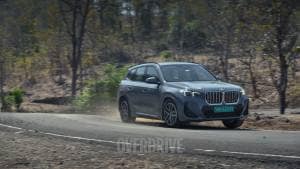2020 Land Rover Defender road test review
The Defender may not have the same illustrious heritage in India as it does internationally, but that doesn't mean it doesn't hit you with a primal urge to go explore, or find adventure, every time you look at its simple, rugged exteriors. Those urges, for most who buy it, will probably end up being satiated with a trip to the mall, or stretching further, to the farmhouse. But image is everything, and the Defender already has that battle won. Ordinary off-roader the Defender is not, clearly verging more towards a luxury SUV, with a versatile and beautifully crafted cabin that will put rivals to shame. Is the Defender the last word in capable, premium SUVs then?
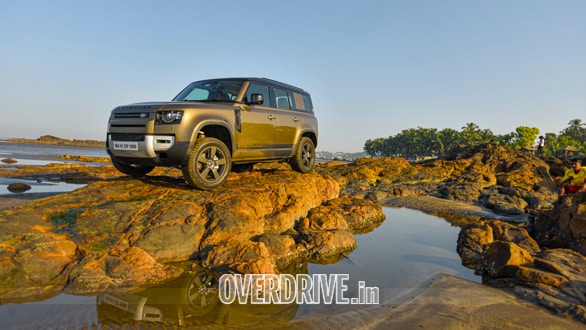
Land Rover Defender platform
Like we said, the Defender isn't an off-roader in the way the Jeep Wrangler, Mercedes-Benz G-Class or the old Defender 90/110 (1983-2016) are, which are underpinned by old-school ladder-on-frame chassis. Based instead on Land Rover's D7X aluminium-intensive platform, the most rigid monocoque it makes, the Defender immediately promises better on-road manners and comfort. It's bespoke to the Defender too and is said to be much stiffer structurally, meaning it should be more capable off the road as well.
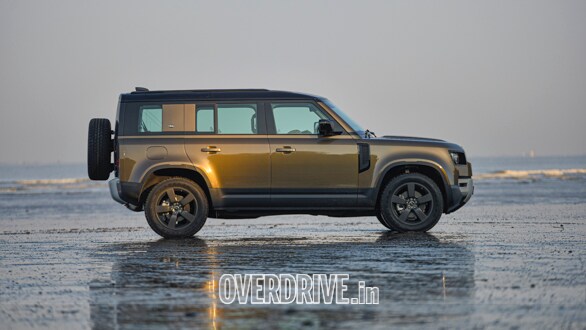
This is good news, since the 110 (five-door) has a massive 3,022mm long wheelbase, meaning it's closer to 119-inches than its name would suggest, and the option of a 5+2 seat configuration. The short-wheelbase, three-door 90 (2,587mm), while launched alongside the 110, will only come to India later. Meanwhile, the Defender has impressive off-roading credentials - numbers that should be of interest to off-road enthusiasts with really deep pockets and courage - 38 degrees approach, 40 degrees departure and 900mm of water wading. That's waist height for most people, and it'll take a brave Defender owner to test it out. Even its 31 degree break over angle is quite competitive to something like the Wrangler's 28 degrees.
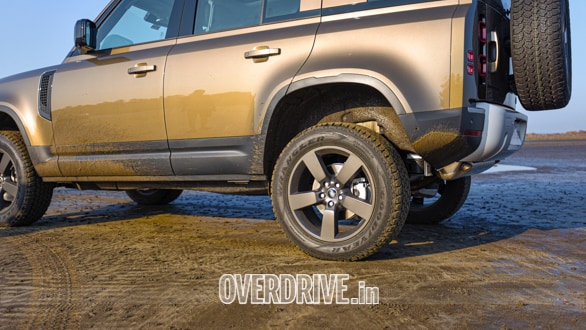
Land Rover Defender styling
The purposeful-looking, 5m long Defender turns heads in the way not many SUVs do. In fact, it's the sort of attention that's usually reserved for hardcore off-roaders, especially when they're spotted in atypical urban environments! Land Rover's design chief, Gerry McGovern, has been hard at work on the original's replacement for over a decade, with the DC100 concept of 2011 giving us a peek at the rough design, while the unreleased LR1 design study fixed some of the negative feedback on that concept.
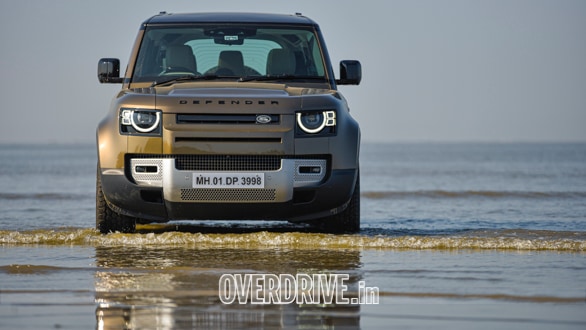
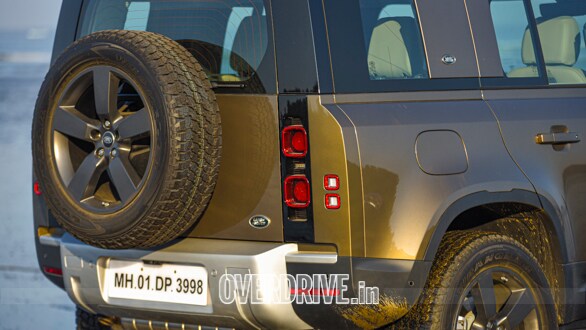
The result is a fuss-free, rounded-yet-boxy design, with modern takes on timeless elements of the Defender, via the circle in square headlights, the flared arches, 'squircle' tail lamps, or even the harder-to-spot Alpine windows over the C-pillar. The front end is quite vertical, as is the rear with the spare-wheel attached, but the raked windscreen does mean its 0.38 coefficient of drag isn't as block-like as, say a G-Class' 0.54. The Defender looks mean, and it means business.
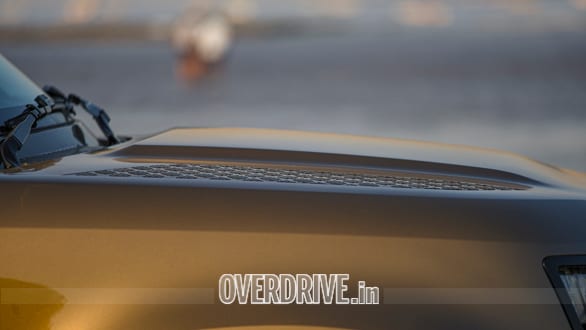
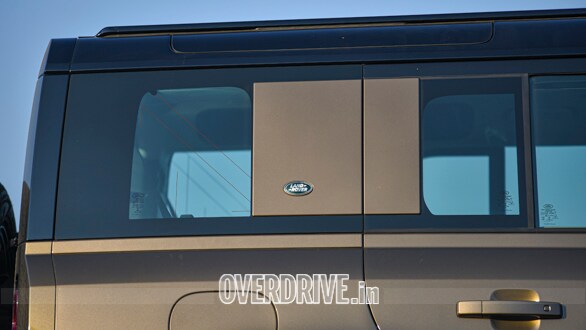
It's bloody functional too, despite the anti-skid plate pattern on the hood being reproduced in plastic, and not actual aluminium. After our day at the beach, hosing the Defender off proved simpler than expected, with sand just rolling off its simple, gently-curved surfaces. Even the slot-like grilles and plastic door sills were easy to get spotless. If you find the air vents on the side offensive, know that the one on the left is functional, and can be fed via an optional snorkel intake. Despite wearing 20-inch wheels, the Defender's fitted with Goodyear AT rubber with a healthy 255/60 section and an aggressive enough pattern to head straight from the showroom into any slush pit of your choosing.
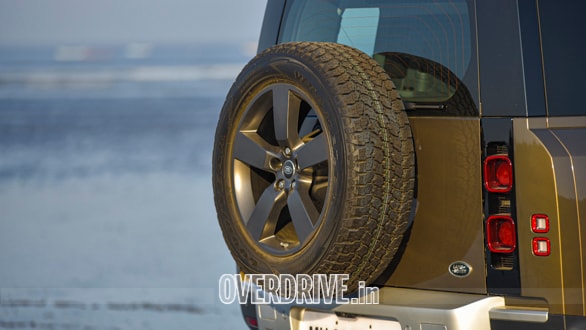
Furthering its credibility right from the showroom, you can spec any of four accessory packs, that add anything from external lockable storage, to functional roof racks with sizable payloads, plastic wheel arch extensions, mud flaps, portable rinse systems, an external ladder to get to your stuff on the roof easier, and side steps (fixed or deployable) to help you climb into the cabin. It's not entirely necessary thanks to the Defender lowering itself 40mm to its access height when a door is opened, but it still is a climb up. The most interesting accessory just may be the Expedition roof rack, which can then be paired with a roof-top tent making for an instant (and legal) overlander.
Land Rover Defender interiors
Like its exterior design, the Defender's cabin has an old-school, pared back sensibility that's immediately likeable. Even more so because you tower over traffic inside it, and everything's laid out so thoughtfully. And the quality of materials. Wow. It's like a minimalist's dream log cabin in here, with hints of ruggedness in the exposed metal, torx head screws and open-pore wood, mixed with extremely satisfying to touch soft textured trim, and rubbery plastic everywhere else. The floors are covered with the stuff too, and while you can't hose out the interior, a simple wipe with a wet cloth removed the remnants of beach from cabin. Though, some of the lighter-coloured materials on the doors, multiple grab handles and steering wheel may pick up dirt faster that you'd like, so choose from the upholstery options list wisely.

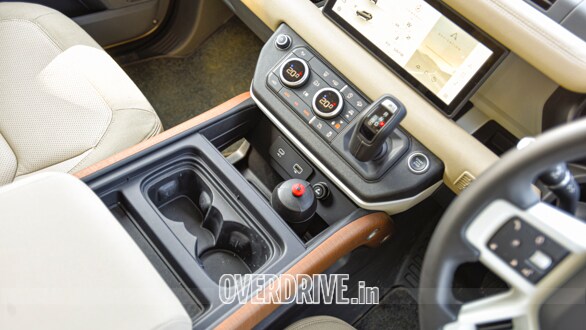
The 10-inch infotainment screen (running new software that can take OTA updates) is fixed to the flat dash in a way that makes it look like its holding it together, and it frees up tonnes of storage spaces. Handy for face masks, sanitisers and the rest of your COVID-survival toolkit, while making the central tunnel storage free for other stuff. The gear shifter sits high up and close to the wheel simply because if you didn't want the two-tier central storage (with a cooled box) you could opt for a jump seat in the middle, or nothing at all to make walking into the second row easier, expanding your Defender's versatility even further.
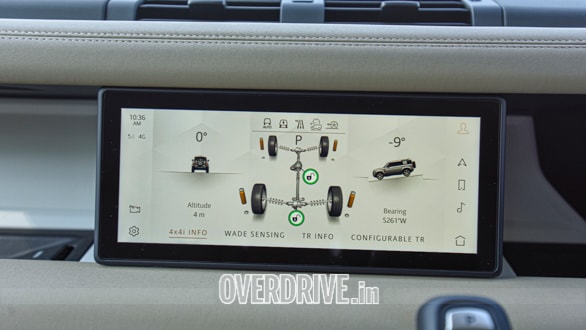
The new Pivi Pro infotainment deserves special mention, being far more fluid and easier to use on the go, even giving you one-touch shortcuts to the supremely useful 360-degree cameras when you've got your smartphone on the screen. The cameras take some getting used to, since the field of view doesn't quite match what you see in the narrow outer mirrors, but you soon learn to trust them. The ClearSight inner rear view camera is especially useful, since the headrests and tailgate-mounted spare don't leave you with much visibility out the rear. The features list is long, even on this mid-range SE model, with multiple USB/12V charge points, keyless entry, a great Meridian sound system, 12-way powered front seats, 360-degree camera and ClearSight, two-zone climate control, and more.
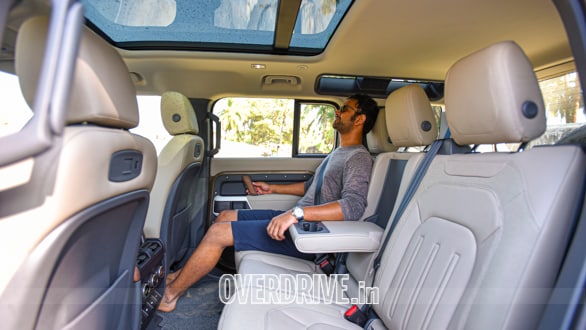
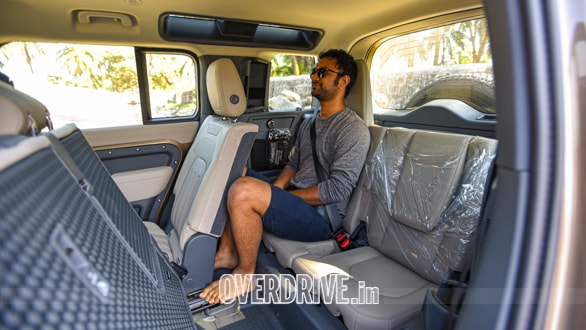
Sat in the second row, you're treated to a great view out the panoramic sunroof, with a comfortable bench that slides and reclines. Third row occupants better be kids, since the 5+2 seating is best suited to them, though the novel Alpine windows add an extra dimension to the roominess. The tailgate mounted full-size spare brings with it extra peace of mind, and the tailgate swings open to reveal 231-litres of boot space with the third row in place (916-litres with it down), against something like the Audi Q7's 295-litres, though the spacesaver in that car did negate the larger number.
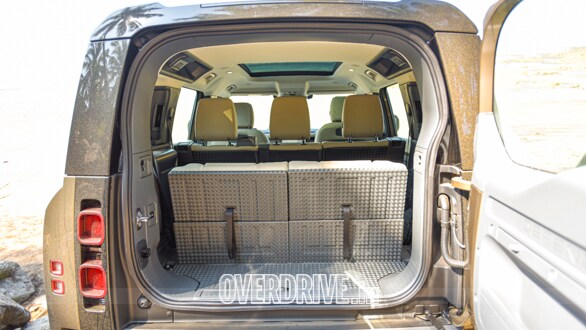
Land Rover Defender engine and performance
Armed with a 2-litre, four-cylinder Ingenium turbo-petrol, the 2.3-tonne Defender may seem a little under-engined, but its 300PS/400Nm outputs are fairly healthy. In the city, you'll find that the impressively silent engine gets the job done, with smooth, seamless shifts from the 8-speed automatic.
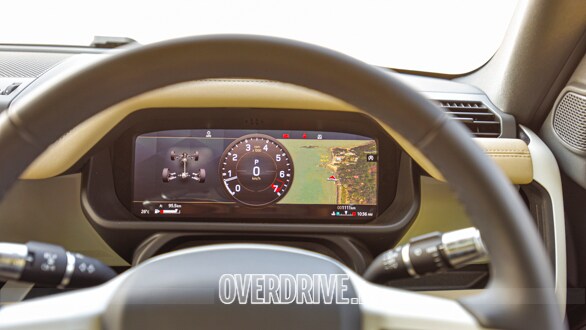
If you're in a hurry, you'll see the digital tacho make frequent trips towards the other side of 3,000rpm, and you'll start wondering why the powertrain doesn't have paddle shifters. This gearbox, as we've found before, is quite laid back in its reactions especially under kickdown, and though the petrol's torque comes in around 1,500rpm, you only feel it building steam around 2,500rpm, before redlining at 6,500 revs. Though on the highway, the Defender has fairly long legs (with the bongs from the speed alerts being quite unobtrusive) and gets up to speed quickly if you don't mind revving it out. The Terrain Response system (in the optional second-gen, updated with a user-configurable mode, and auto mode) lacks a sport/dynamic mode, which is fair considering the intended use of the Defender, but it could have sharpened up the gearbox's responses.
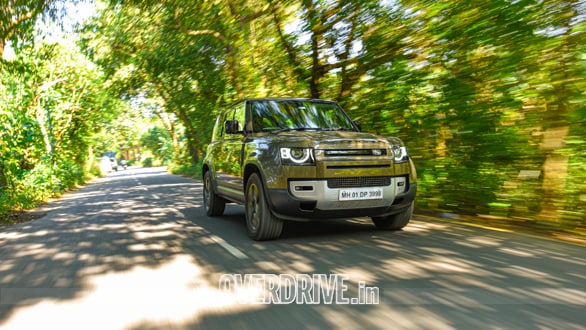
Our roll-on performance tests (times around 2.2-2.4s between 30-50, 50-70kmph) give a fair idea of where the Defender's powertrain stands, while its 0-100kmph dash in 8.9 seconds is off the claimed figure of 8.1 seconds for this engine spec. The six-cylinder petrol and diesel engines are said to be planned for next year, and the 550-570Nm torque rating on those engines sounds more apt to move the Defender's mass. Of course, the 2-litre engine being asked to do more than it should shows in its efficiency, giving us 5kmpl over our city test route, and 9.8kmpl over our highway testing at a steady 100kmph.

Land Rover Defender ride and handling
The more time you spend in the Defender, the more you'll appreciate its ride quality. Typical of air-suspension equipped cars (110 gets air damping as standard in India), there's a slight firmness at lower speeds, with sharp edges just about filtering through, but not quite landing the jolt you expect. Around 70kmph and up, the Defender's ride comes into its own, and you can feel its double wishbones (front), multilinks (rear), air suspension and high-profile tyres flattening the road under you, no matter the surface. It gives the Defender a feeling of invincibility that can get addictive. And the trade-off isn't excessive body movements either. Over an undulating road, you feel the Defender move a little side-to-side, but it doesn't detract from the experience.
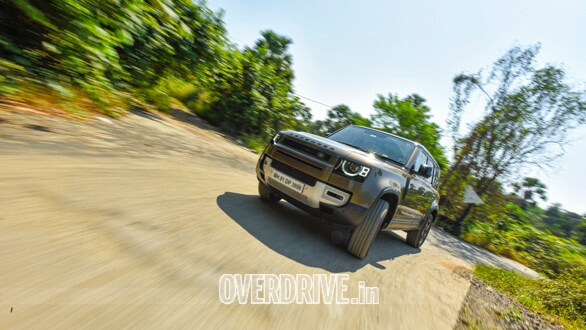
That doesn't mean you should be throwing the Defender into corners, though it holds its own well enough after leaning in and settling on its tall AT tyres. The steering (whether in Comfort or Eco) feels manageably light at lower city speeds, making light work of lock-to-lock U-turns, a feat considering the Defender's over 5m long footprint. Even driving through the surf on the beach, there's enough feel coming through the wheel to know when you're overdoing it. The Defender's too large to go hunting for apexes, obviously, but as a highway hauler it'll manage admirably.
Land Rover Defender off-road
The question does arise whether Defender owners are going to take their expensive SUVs off road in the first place, but with its all-wheel drive, two-speed transfer case with a low ratio, and electronically locking differentials front and rear, you owe it to yourself to try a little more than greenlanding.
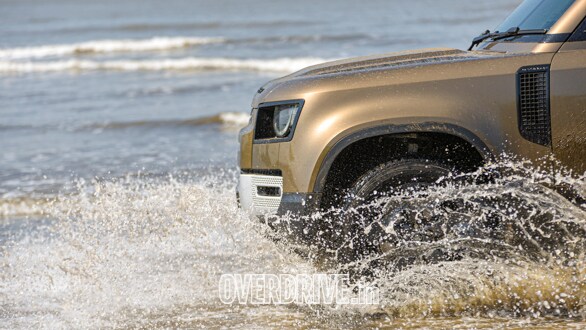
First up, all the Defender's electronics are IP67-rated, safe from immersion which made us comfortable enough to take it to the beach in the first place. In the sea, at a distance far enough from the shore that made me uncomfortable, the wade sensors (trick bit of ultrasonic tech, this) barely registered 0.1m, with 800mm more to go. Switching the Terrain Response 2 system (optional) to Sand mode softens up the initial bit of throttle response, and holds on to gears longer to make sure you don't lose momentum when you least expect it. We can say it did its job well.

Switching to auto gave the Defender enough engine response at low speeds for the kind of technical off-roading that climbing over rocks ensues, and putting it in its highest off-road ride height gets you 75mm more clearance over its standard 216mm. The most handy bit of tech has to be the ClearSight Groundview camera (only on the Evoque and Defender so far), which gives you a 180-degree view of what's happening under the hood of the car, allowing you to accurately place your wheels between, and over rocks, or kerbs when you're parking - likely to be the more used scenario.
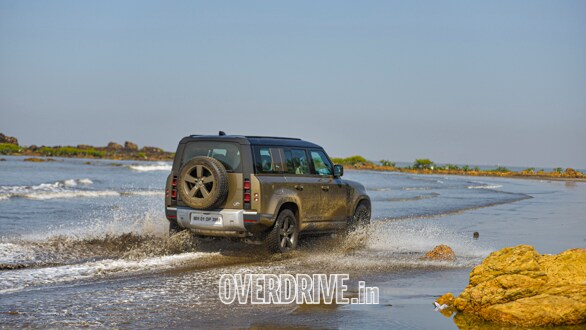
Land Rover Defender verdict
Over something like the Jeep Wrangler, the Defender is actually a no-brainer, being far better behaved on road and likely not that far off from it off the road. If you had the Rs 1.1 crore asking price (on-road, Mumbai), the Defender certainly would seem like it goes up favourably against luxury SUVs too, with its beautiful cabin and overall versatility being highlights, not to mention its unique looks and off-road abilities that will blow any other luxury SUV out of the water. Most importantly, it's got that character that we spoke about - that makes you want to go out and explore. That's priceless.
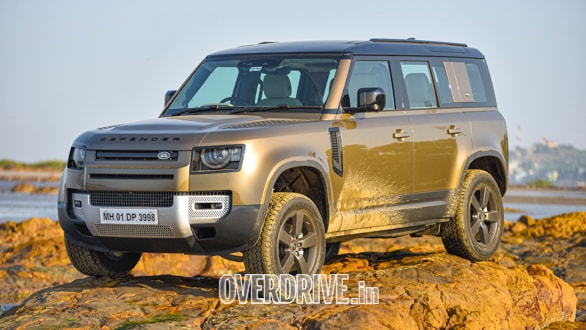
Starts Rs 73.98 Lakhs
2996cc
Automatic
300
650
-NA-
Starts Rs 79.99 Lakhs
2984cc
Automatic
340
500
-NA-
Starts Rs 53.9 Lakhs
1995cc
Automatic
268
400
-NA-
Starts Rs 1.5 Crore
2925cc
Automatic
286
600
-NA-

